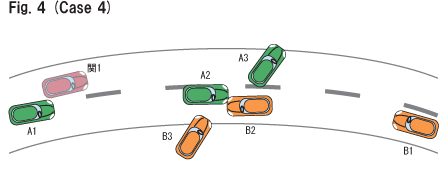
|
Case 3 (Fig. 3)
- Outline of Accident
Car A (ordinary passenger car; female driver in her 20s) was moving at about 50 km/h on a 6-m-wide, two-lane road at about 2 o'clock on a clear night. The driver tried to retrieve something that had fallen on the car floor, was briefly distracted, and drove into the opposite lane. The car collided with Car B (ordinary-size passenger car; male driver in his 20s) that was coming from the opposite direction.
|
- Accident Pattern
Vehicle-to-vehicle, frontal collision
|
- Year of Vehicle's First Registration, Vehicle Weight
Car A (Photos 9 and 10): 1986, ordinary-size passenger car, 965 kg
Car B (Photos 11 and 12): 1991, ordinary-size passenger car, 1,740 kg
|
- Degree of Injury
Car A driver (no airbag; seatbelt not fastened): Seriously injured
Car B driver (no airbag; seatbelt not fastened): Slightly injured
Car B passenger (no airbag; seatbelt not fastened): Slightly injured
|
|

|
|
|
|
|
|
- Discussion
The photos of Case 3 show extensive damage to the entire body of Car A, with the front part deeply crushed in, compared with accidents involving passenger cars designed under the new concept (Cases 1 and 2). The impact of the collision extended from the front pillar to the roof and the center pillar, denting the vehicle's body in the middle (see Photo 9). The car, manufactured two decades ago, did not have the type of structure to effectively absorb the impact energy in the front part and minimize passenger-compartment distortion, as current models do.
The driver of Car A, with her seatbelt not fastened and with large distortion in the passenger compartment (Photo 10), was seriously injured (open fracture of thighbone, knee fracture, and head bruise). The driver and the passenger of Car B sustained minor injury, with bruises and cuts.
|
|
Case 4 (Fig. 4)
- Outline of Accident
Car A (ordinary-size passenger car; male driver in his 20s) was traveling at approximately 70 km/h on a 6-m-wide, two-lane road at about 11 o'clock on a cloudy night. Trying to overtake a car in front (C1), the car strayed into the opposite lane and crashed into Car B (ordinary-size passenger car; female driver in her 40s) that was approaching in the opposite lane.
|
- Accident Pattern
Vehicle-to-vehicle, frontal collision
|
- Year of Vehicle's First Registration, Vehicle Weight
Car A (Photos 13 and 14): 1990, ordinary-size passenger car, 995 kg
Car B (Photos 15 and 16): 1986, ordinary-size passenger car, 1,165 kg
|
- Degree of Injury
Car A driver (no airbag; seatbelt not fastened): Seriously injured
Car B driver (no airbag; seatbelt fastened): Seriously injured
|
|

|
|
|
|
|
|
- Discussion
This case is also an offset collision. The front part of Car A (Photo 13) was crushed to an even greater degree than that of Car A in Case 3 (Photo 9), with the doors opening and the distortion extending as far as the rear part of the vehicle. With his seatbelt not fastened and with large distortion (Photo 14 driver's seat, space reduced by 75cm) in the passenger compartment, the driver of Car A sustained serious injury, pelvic and facial fractures, which took six months to heal. The driver of Car B, even though wearing her seatbelt, suffered subarachnoid hemorrhage (healed in 30 days).
|
|
|
UP
Back Next
|
